Abstract
NADPH- and ascorbic acid-induced microsomal lipid peroxidation was almost absent in subcutaneously implanted DAB-induced hepatomas D23, D30 and D192A, and present at greatly reduced levels in DAB-induced primary hepatomas when compared with normal liver controls. Fatty acid analysis of the microsomal lipid from passaged tumours demonstrated adequate levels of substrate in the phospholipid fractions to support lipid peroxidation. Lipid extracted from hepatoma microsomal fractions was shown to undergo ascorbic acid-induced lipid peroxidation, but to a lesser extent that the corresponding liver extract. This may be partially explained by a decrease in the phospholipid content of hepatoma microsomal membranes. However, phospholipid extracted from microsomal fractions of hepatoma and liver supported lipid peroxidation to a similar extent. The possible role of the non-lipid component of the membrane in the process of lipid peroxidation is discussed.
Full text
PDF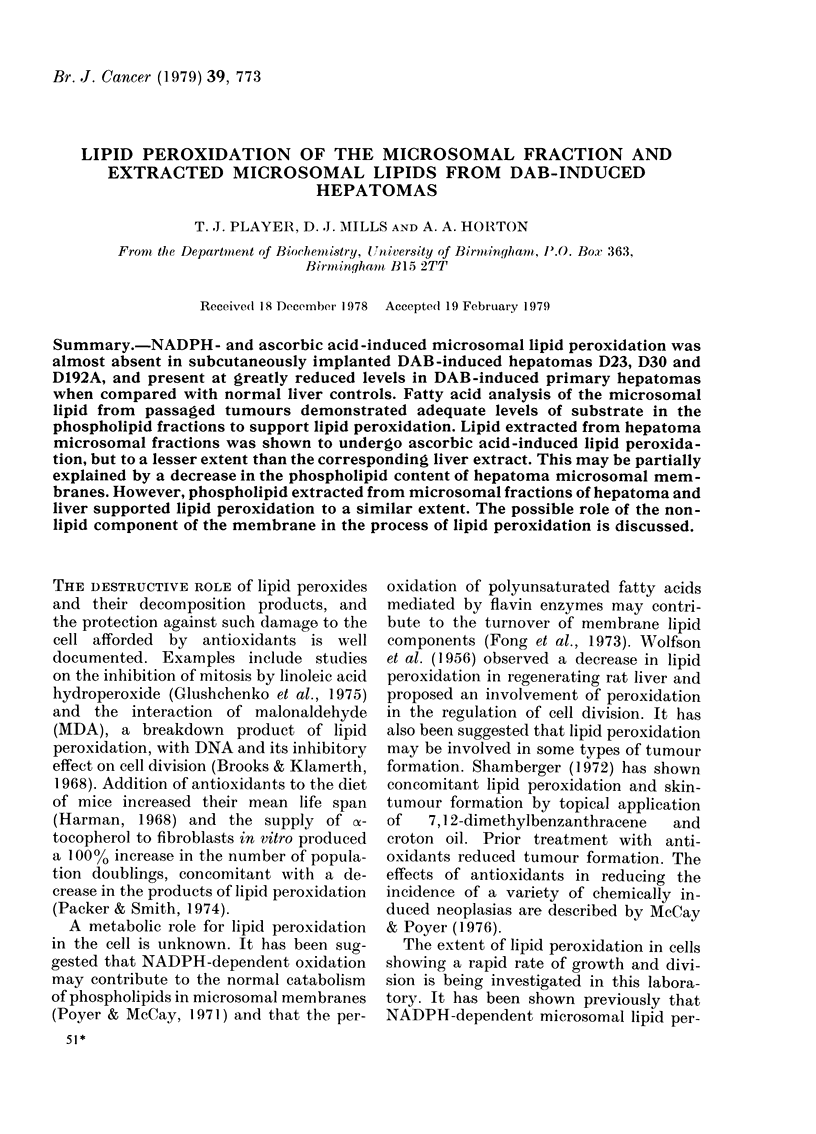
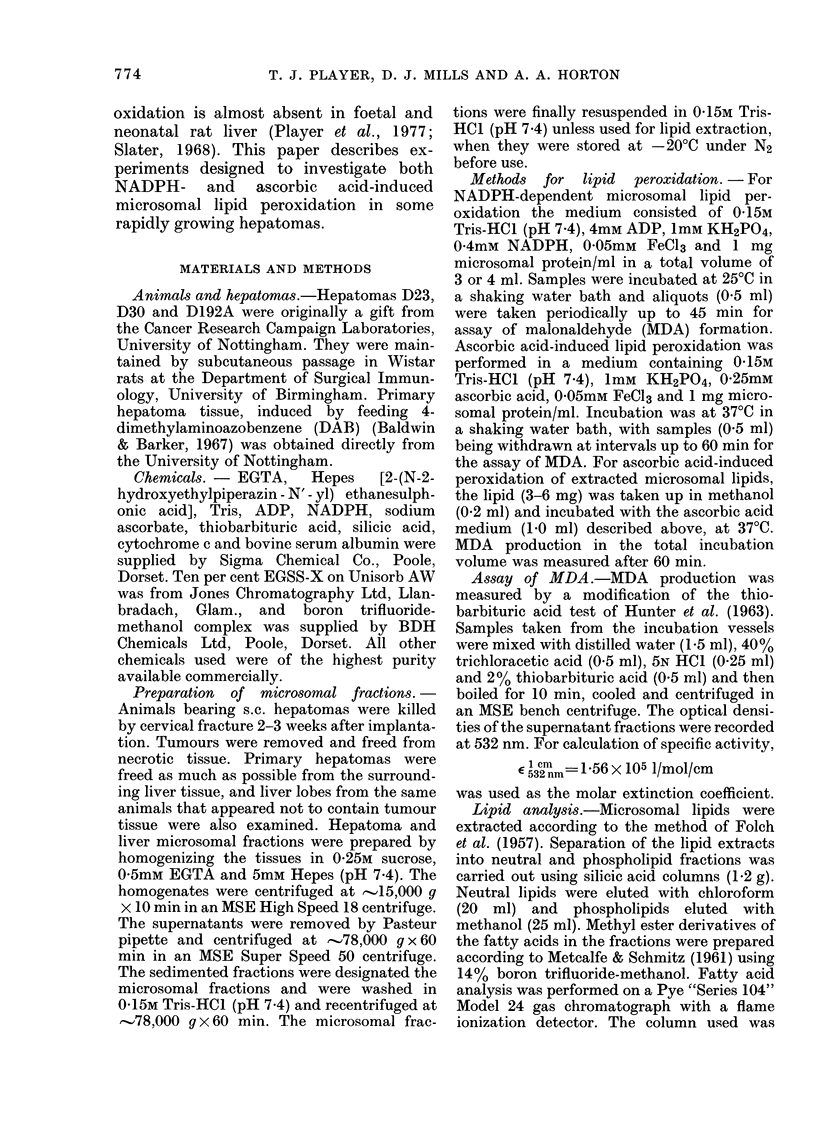
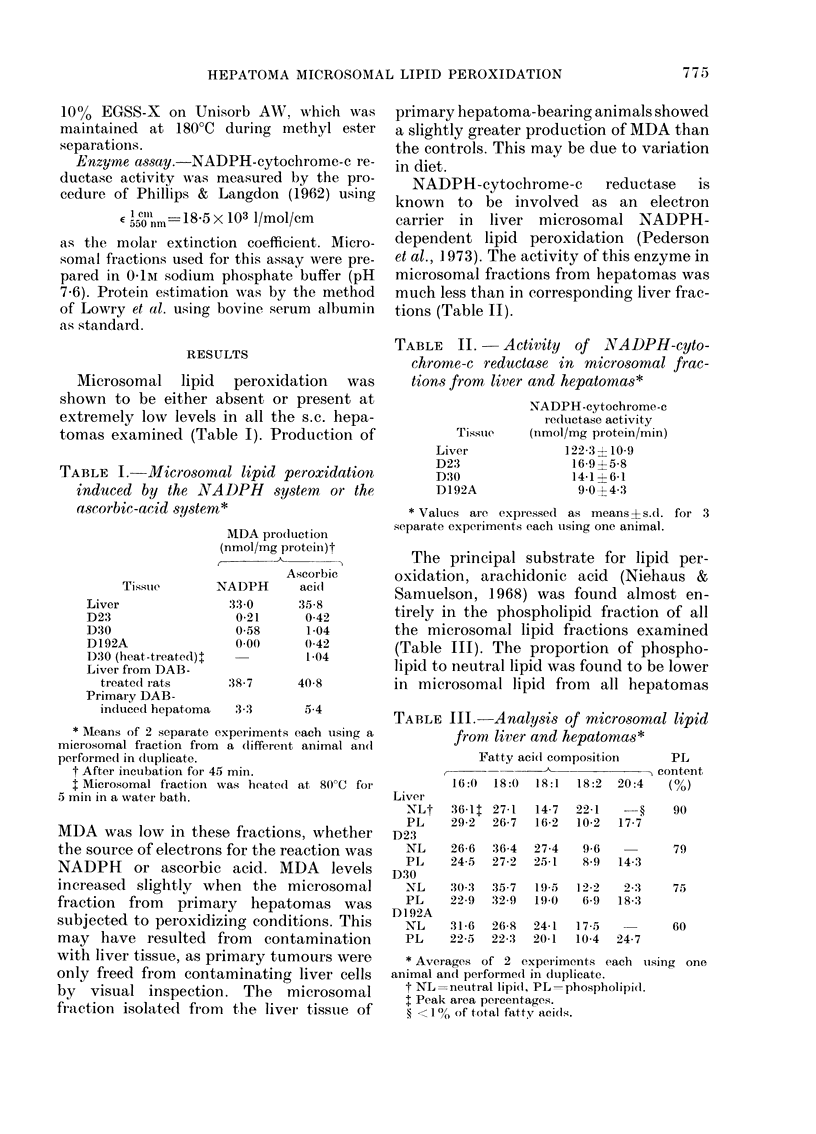
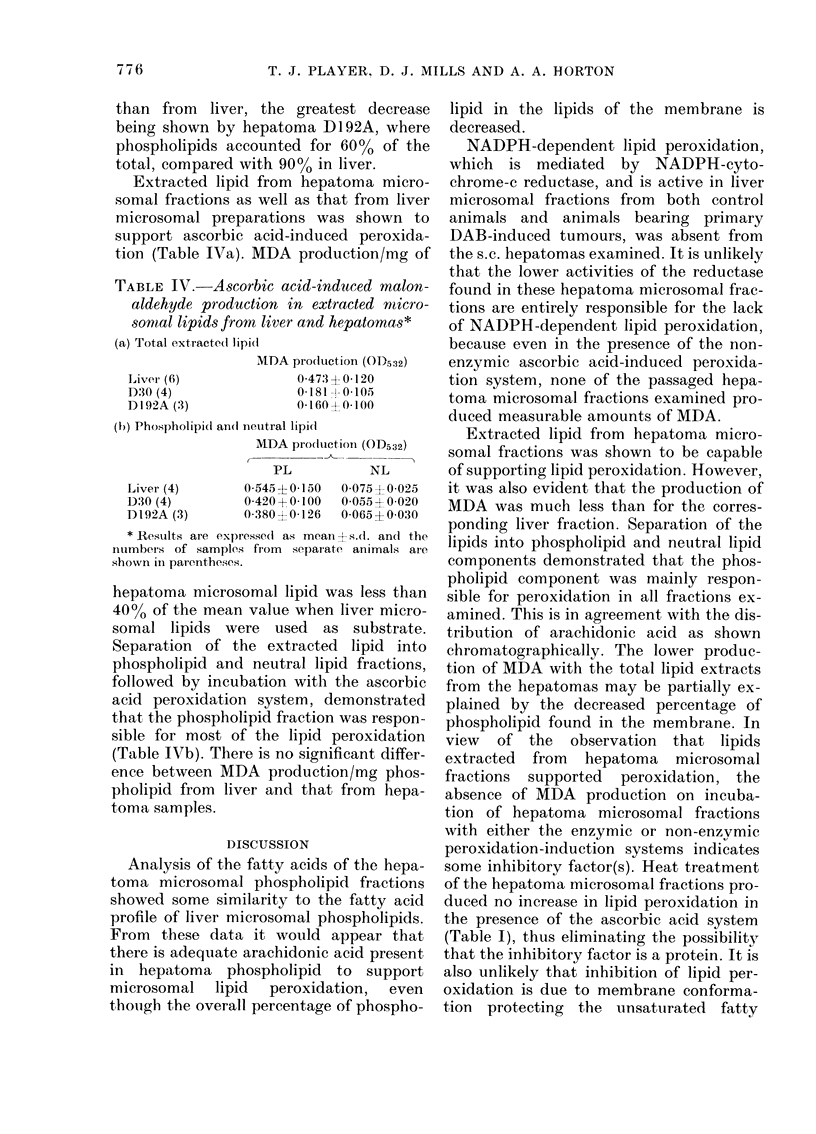
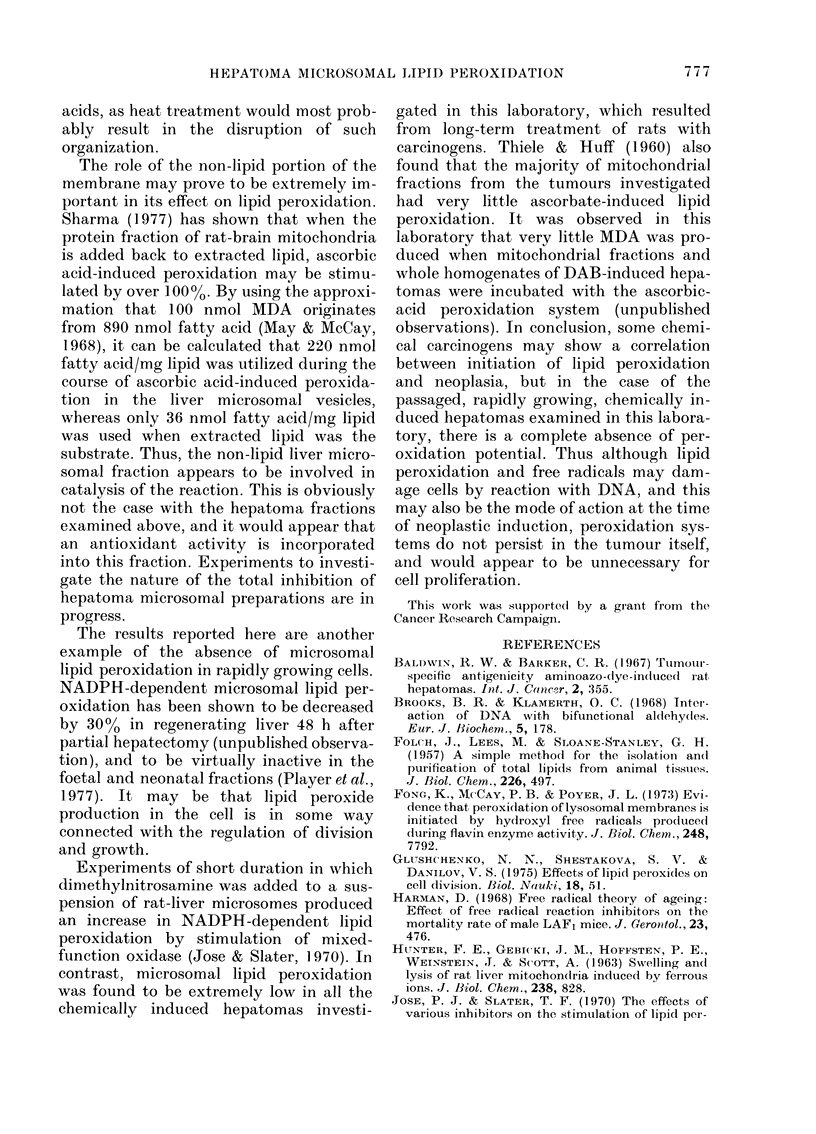
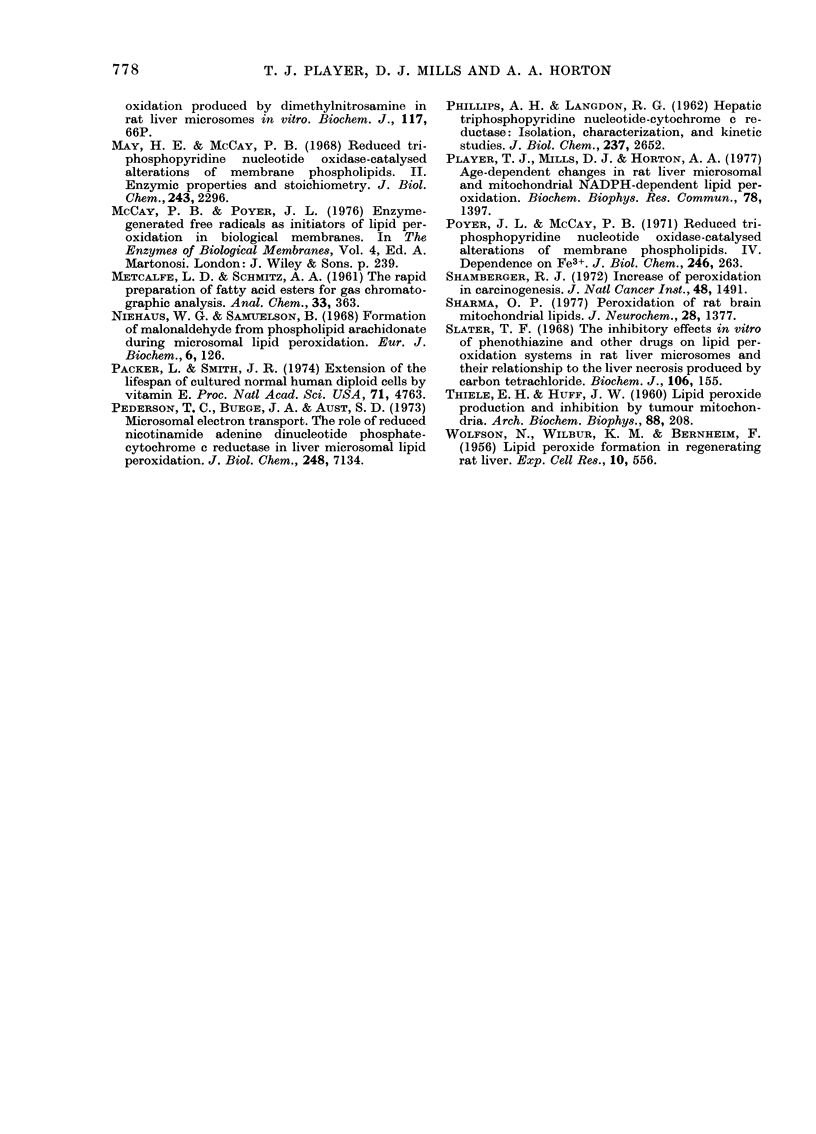
Selected References
These references are in PubMed. This may not be the complete list of references from this article.
- Brooks B. R., Klamerth O. L. Interaction of DNA with bifunctional aldehydes. Eur J Biochem. 1968 Jul;5(2):178–182. doi: 10.1111/j.1432-1033.1968.tb00355.x. [DOI] [PubMed] [Google Scholar]
- FOLCH J., LEES M., SLOANE STANLEY G. H. A simple method for the isolation and purification of total lipides from animal tissues. J Biol Chem. 1957 May;226(1):497–509. [PubMed] [Google Scholar]
- Fong K. L., McCay P. B., Poyer J. L., Keele B. B., Misra H. Evidence that peroxidation of lysosomal membranes is initiated by hydroxyl free radicals produced during flavin enzyme activity. J Biol Chem. 1973 Nov 25;248(22):7792–7797. [PubMed] [Google Scholar]
- HUNTER F. E., Jr, GEBICKI J. M., HOFFSTEN P. E., WEINSTEIN J., SCOTT A. Swelling and lysis of rat liver mitochondria induced by ferrous ions. J Biol Chem. 1963 Feb;238:828–835. [PubMed] [Google Scholar]
- Harman D. Free radical theory of aging: effect of free radical reaction inhibitors on the mortality rate of male LAF mice. J Gerontol. 1968 Oct;23(4):476–482. doi: 10.1093/geronj/23.4.476. [DOI] [PubMed] [Google Scholar]
- Jose P. J., Slater T. F. The effects of various inhibitors on the stimulation of lipid peroxidation produced by dimethylnitrosamine in rat liver microsomes in vitro. Biochem J. 1970 Apr;117(3):66P–67P. doi: 10.1042/bj1170066p. [DOI] [PMC free article] [PubMed] [Google Scholar]
- May H. E., McCay P. B. Reduced triphosphopyridine nucleotide oxidase-catalyzed alterations of membrane phospholipids. II. Enzymic properties and stoichiometry. J Biol Chem. 1968 May 10;243(9):2296–2305. [PubMed] [Google Scholar]
- Niehaus W. G., Jr, Samuelsson B. Formation of malonaldehyde from phospholipid arachidonate during microsomal lipid peroxidation. Eur J Biochem. 1968 Oct 17;6(1):126–130. doi: 10.1111/j.1432-1033.1968.tb00428.x. [DOI] [PubMed] [Google Scholar]
- PHILLIPS A. H., LANGDON R. G. Hepatic triphosphopyridine nucleotide-cytochrome c reductase: isolation, characterization, and kinetic studies. J Biol Chem. 1962 Aug;237:2652–2660. [PubMed] [Google Scholar]
- Packer L., Smith J. R. Extension of the lifespan of cultured normal human diploid cells by vitamin E. Proc Natl Acad Sci U S A. 1974 Dec;71(12):4763–4767. doi: 10.1073/pnas.71.12.4763. [DOI] [PMC free article] [PubMed] [Google Scholar]
- Pederson T. C., Buege J. A., Aust S. D. Microsomal electron transport. The role of reduced nicotinamide adenine dinucleotide phosphate-cytochrome c reductase in liver microsomal lipid peroxidation. J Biol Chem. 1973 Oct 25;248(20):7134–7141. [PubMed] [Google Scholar]
- Player T. J., Mills D. J., Horton A. A. Age-dependent changes in rat liver microsomal and mitochondrial NADPH-dependent lipid peroxidation. Biochem Biophys Res Commun. 1977 Oct 24;78(4):1397–1402. doi: 10.1016/0006-291x(77)91447-4. [DOI] [PubMed] [Google Scholar]
- Poyer J. L., McCay P. B. Reduced triphosphopyridine nucleotide oxidase-catalyzed alterations of membrane phospholipids. IV. Dependence on Fe3+. J Biol Chem. 1971 Jan 10;246(1):263–269. [PubMed] [Google Scholar]
- Shamberger R. J. Increase of peroxidation in carcinogenesis. J Natl Cancer Inst. 1972 May;48(5):1491–1497. [PubMed] [Google Scholar]
- Sharma O. P. Peroxidation of rat brain mitochondrial lipids. J Neurochem. 1977 Jun;28(6):1377–1379. doi: 10.1111/j.1471-4159.1977.tb12335.x. [DOI] [PubMed] [Google Scholar]
- Slater T. F. The inhibitory effects in vitro of phenothiazines and other drugs on lipid-peroxidation systems in rat liver microsomes, and their relationship to the liver necrosis produced by carbon tetrachloride. Biochem J. 1968 Jan;106(1):155–160. doi: 10.1042/bj1060155. [DOI] [PMC free article] [PubMed] [Google Scholar]
- THIELE E. H., HUFF J. W. Lipide peroxide production and inhibition by tumor mitochondria. Arch Biochem Biophys. 1960 Jun;88:208–211. doi: 10.1016/0003-9861(60)90223-x. [DOI] [PubMed] [Google Scholar]
- WOLFSON N., WILBUR K. M., BERNHEIM F. Lipid peroxide formation in regenerating rat liver. Exp Cell Res. 1956 Apr;10(2):556–558. doi: 10.1016/0014-4827(56)90031-3. [DOI] [PubMed] [Google Scholar]


